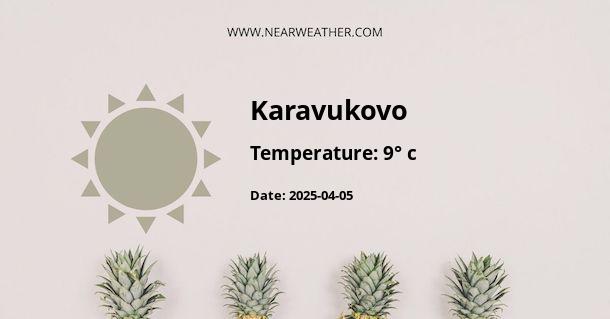Understanding Karavukovo Climate and Weather Patterns
The small town of Karavukovo, located in the autonomous province of Vojvodina within Serbia, experiences a continental climate characterized by hot summers and cold winters. This complex weather pattern is influenced by several geographic factors including its position in the Pannonian Plain, proximity to the Danube River, and relative distance from the Adriatic Sea which could moderate extremes. As we delve into the climate specifics of Karavukovo, it's important to examine the meteorological data, seasonal variations, and the impact these patterns have on local life.
Temperature Variability Throughout the Year
In Karavukovo, temperatures vary significantly throughout the year. With warm to hot summers and cold winters, the town witnesses a broad range in the temperature spectrum.
| Season | Temperature Range °C | Description |
|---|---|---|
| Winter | -5 to 5 | Winters are cold, with sub-zero temperatures and frequent frost. Snowfall is common, contributing to the chilly climate. |
| Spring | 5 to 20 | Spring sees a gradual warming with fluctuating conditions. Late spring brings more consistent warmer weather. |
| Summer | 18 to 30+ | Summers are typically hot with occasional heatwaves where temperatures can exceed 35°C. Evenings are generally cooler. |
| Autumn | 5 to 20 | Falling temperatures and increased precipitation mark autumn. It starts warm but gradually cools down as winter approaches. |
Precipitation and Humidity Patterns
Precipitation is fairly evenly distributed throughout the year in Karavukovo but reaches its peak during the warmer months, often in the form of thunderstorms.
"Karavukovo experiences an annual precipitation rate of approximately 600 millimeters, indicating a moderate level of rainfall overall."
- Spring: Rainfall begins to increase with occasional storms contributing to the springtime rebirth of local flora.
- Summer: This season is when the heaviest downpours and storms typically happen, which can sometimes lead to local flooding.
- Autumn: The rainfall persists into autumn but becomes less intense as the season progresses.
- Winter: Snow and freezing rain are common. Snow cover varies but can be persistent due to the cold temperatures.
Wind and Atmospheric Conditions
In terms of wind, Karavukovo receives moderate breezes year-round, with certain seasonal winds - such as the Košava - affecting the region particularly in autumn and spring. These winds can be quite strong and persistent, influencing not just the weather but also transport and agriculture.
Climate Impact on Agriculture and Lifestyle
With the Pannonian Plain being a significant agricultural zone, the climate in Karavukovo greatly influences the agricultural practices and crop cycles throughout the year.
- Spring Crops: With the softening soil and increasing temperatures, it's an ideal time for planting early crops.
- Summer Heat: This is critical for the growth of grains like wheat and corn, which are prominent in the area.
- Autumn Harvest: The moderate temperatures allow for the harvesting of crops planted in spring and summer.
- Winter Dormancy: While some hearty vegetables can survive the colder months, most agricultural activity hibernates during winter.
"The climate in Karavukovo presents both a challenge and an advantage to local farmers, requiring them to adapt their practices to the cyclical and sometimes extreme weather conditions."
Extreme Weather Events and Climate Change
Like many regions, Karavukovo is not immune to extreme weather. Its proximity to the Danube can raise the risk of flooding during heavy rainfall, and summers are prone to heat waves that can stress both the population and infrastructure.
- Flooding often becomes a concern during spring and after rapid snowmelts.
- Heatwaves, more frequent in recent times due to climate change, pose health risks.
- The intensity and frequency of extreme weather events have increased, in line with global patterns attributed to climate change.
Forecasting for Karavukovo: Tools and Techniques
Accurate weather predictions are vital for the small community of Karavukovo. Meteorologists use a combination of local weather data, satellite imagery, and computer modelling to forecast the weather. Advanced notice of extreme weather conditions is critical to safeguarding the community and its agricultural base.
Local Forecasting
Local meteorologists track temperature, precipitation, humidity, wind speed, and direction, amongst other metrics. The Republic Hydrometeorological Service of Serbia is the national authority that provides weather forecasts and warnings for Karavukovo and the wider region. Real-time data is collected from radar, weather stations, and river gauges especially important for monitoring flood risk.
Conclusion
In conclusion, the weather and climate of Karavukovo embody the wide range characteristic of continental climates. This has shaped both the natural environment and the human activities of the region. Understanding these patterns is crucial for predicting seasonal changes, preparing for extreme events, and managing the agricultural livelihoods that depend on this land. As climate change continues to influence weather patterns globally, communities like Karavukovo must adapt and plan for a future with potentially more varied and extreme weather.
A - Karavukovo's Latitude is 45.494999 & Longitude is 19.188061.
A - Weather in Karavukovo is 9° today.
A - Climate Conditions in Karavukovo shows light rain today.
A - Humidity in Karavukovo is 75% today.
A - Wind speed in Karavukovo is 8.24 km/h, flowing at 244° wind direction. today.
